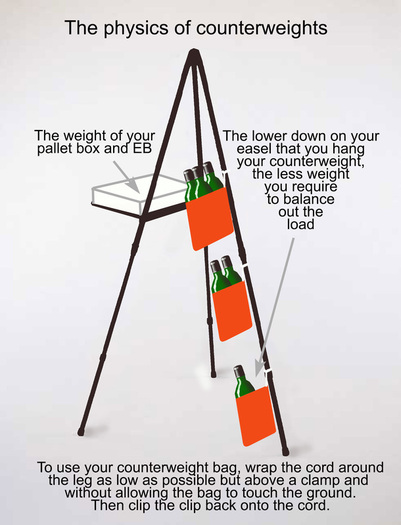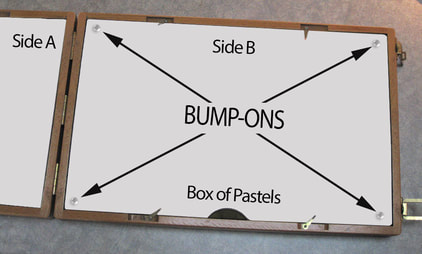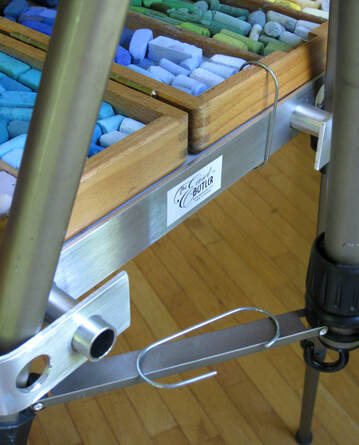Varying the height on your easel
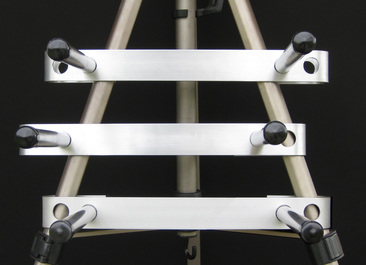
These three easel butlers on the right show the difference in height that can be achieved on your tripod by using various hole configurations for your arms and altering whether the arms sit on the outside or inside of the tripod legs. See the video
On my FeatherlitePro 190 easel, when I am standing, the lowest level for Max is 86 cm or 34 inches from the ground and the highest level stands 104 cm or 41 inches off the ground. Keep in mind that each measurement is dependent on the slope of individual easels.
If you paint sitting at your easel, the height of Max can be altered by using any of these configurations and shortening the legs to a comfortable working height for you as you can see in the first photo of Cathy in the Exposé Gallery.
Jann's photo in the Exposé Gallery shows her making use of a Cullmann tripod with the addition of Max as an accessory shelf. By using the top configuration here, she was able to raise her tray much higher off the ground.
On my FeatherlitePro 190 easel, when I am standing, the lowest level for Max is 86 cm or 34 inches from the ground and the highest level stands 104 cm or 41 inches off the ground. Keep in mind that each measurement is dependent on the slope of individual easels.
If you paint sitting at your easel, the height of Max can be altered by using any of these configurations and shortening the legs to a comfortable working height for you as you can see in the first photo of Cathy in the Exposé Gallery.
Jann's photo in the Exposé Gallery shows her making use of a Cullmann tripod with the addition of Max as an accessory shelf. By using the top configuration here, she was able to raise her tray much higher off the ground.
Max mounted in front or to the side?
Max has great features but one of his biggest unsung assets over 'all-in-one' pastel set-ups is his versatility in the choice of mounting positions in relation to your body. Not everyone wants the standard "box in the front" which requires a long reach and also results in excess particulates ending up in said box. Having him hang on the side or both sides of your easel if you have two boxes or shelves leaves you free to get up close and personal ...especially useful if you are myopic or like me, have a bad shoulder and cannot over-reach. See the video
If you already have a particular set-up that you are already in love with, Max can make a useful addition.
If you already have a particular set-up that you are already in love with, Max can make a useful addition.
Counterweight for safe balance
|
Since most art easels are not made to have a great amount of weight attached to just one side of them, you are strongly advised to attach a counterweight to whichever leg on your easel is opposite to the two legs supporting Max. The lower the better as long as your counterweight is fully suspended and not touching the ground. A large bottle of water is a terrific counterweight and disposable for the trip home or....if you prefer a good wine, you can sit back and consume it while admiring your latest creation. Our counterweight bags are a great size for this and have a handy cord and clip for circling the leg but any bag will do. |
Add some bump-ons
|
If your are using a pastel travel box and planning to use the pastel cover boards that come in it as a shelf to support your box, we suggest sticking at least 4 bump-ons onto one of those very slippery boards. Placing one bump-on near each corner will provide a surface with better grip on which to set your pastel box while the memory foam on the other side is a great non-slip surface for both stacking the boards and adhering to the butler. Bump-ons are available through your framing shop or on our product page.
|
D-rings to hold your pastel box open
Smaller pastel boxes may need some 'outside' help in spanning across Max's arms. The addition of four D-rings to the outside of the box can accommodate a small rod to span the hinge area to keep the box from folding up and dropping through the arms. D-rings are available through your framing shop or on our product page.
C hooks help secure this box
|
Skinny legged easel?
If your easel or tripod has legs thinner than 1 inch or 250 mm you should consider whether or not it can withstand the weight of a heavy pastel or paint box. Some easels like the Italian easel are plenty strong but others might have weaker clamps for adjusting the legs which can give out under load....oh no...not my fragile pastels!!
Very thin-legged easels can also cause the arms to droop or slant downward. Shortening the back leg usually works as a fix. We do make custom Easel Butlers, often at no additional cost, should you require something shallower than Max. This however means that our "skinny Max" might not fit on any future easel or tripod you may acquire sometime down the line.
Very thin-legged easels can also cause the arms to droop or slant downward. Shortening the back leg usually works as a fix. We do make custom Easel Butlers, often at no additional cost, should you require something shallower than Max. This however means that our "skinny Max" might not fit on any future easel or tripod you may acquire sometime down the line.
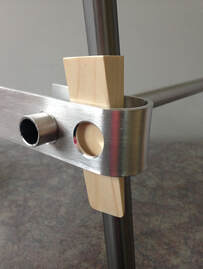
However, if you just love the easel you have or perhaps want to be able to use Max on more than one size of easel, then you might consider this simple fix.
One can slip in wooden wedges like these ones to take up the excess room.
These are easily made by a handyman or are available on our purchase page.

